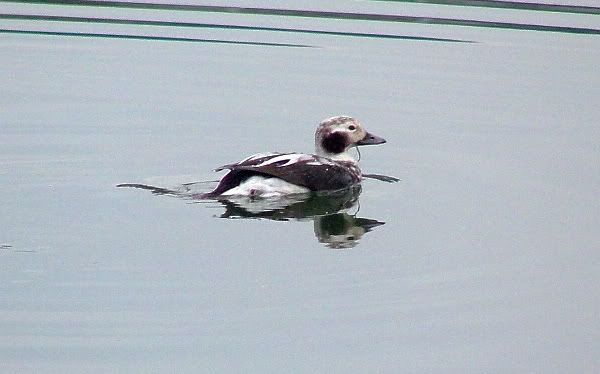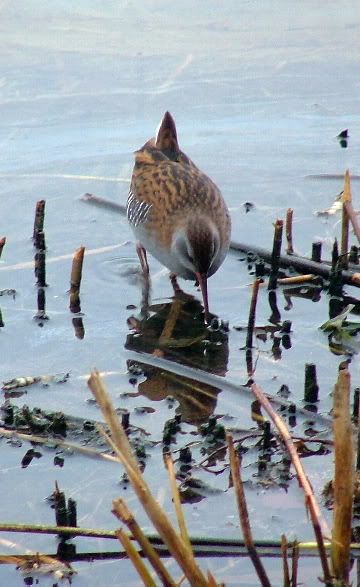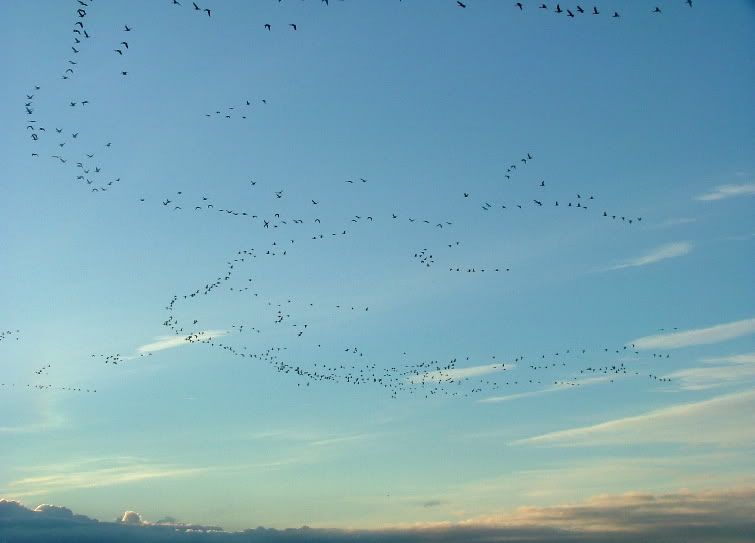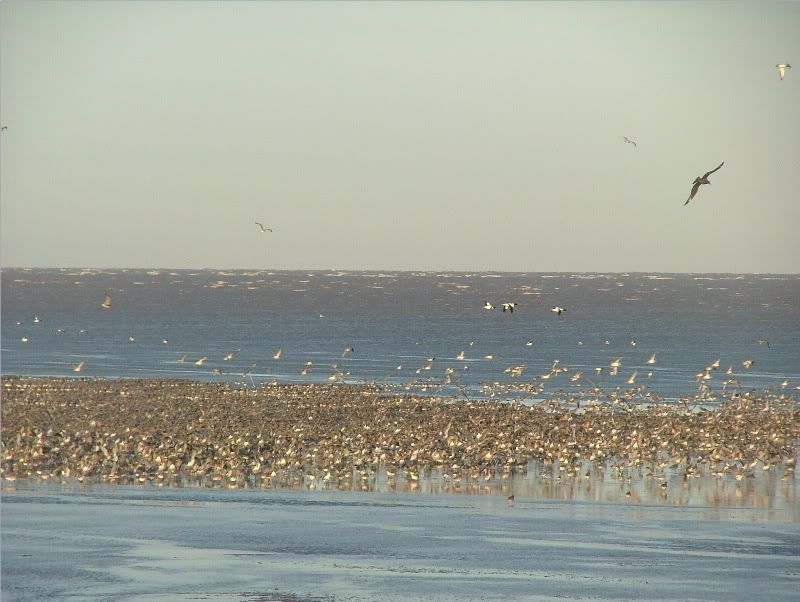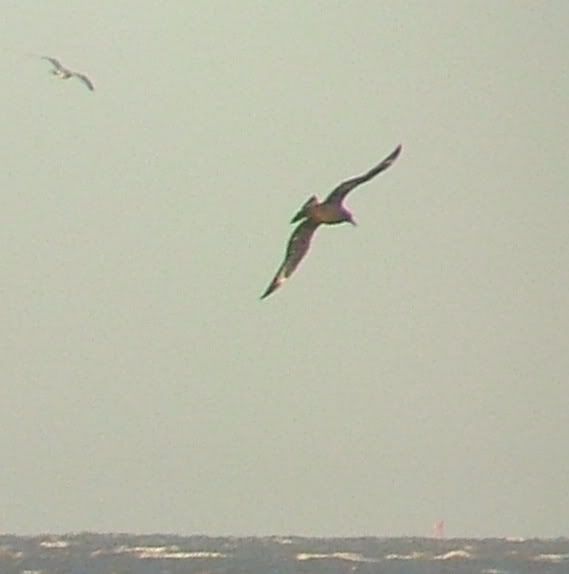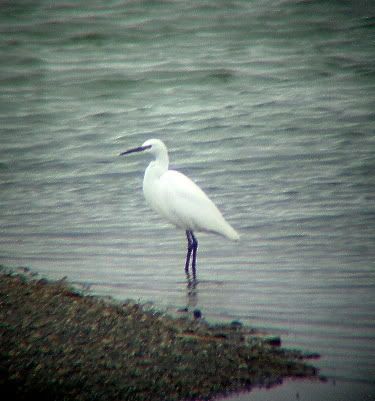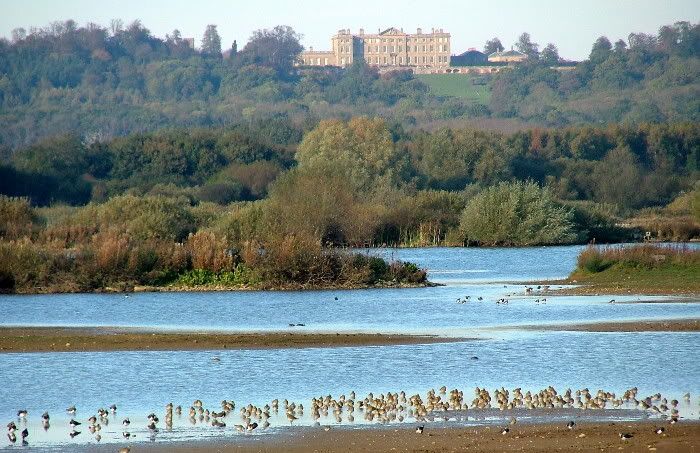
Monday 31 December 2007
Monday 24 December 2007
Bittern by the Bird Bog
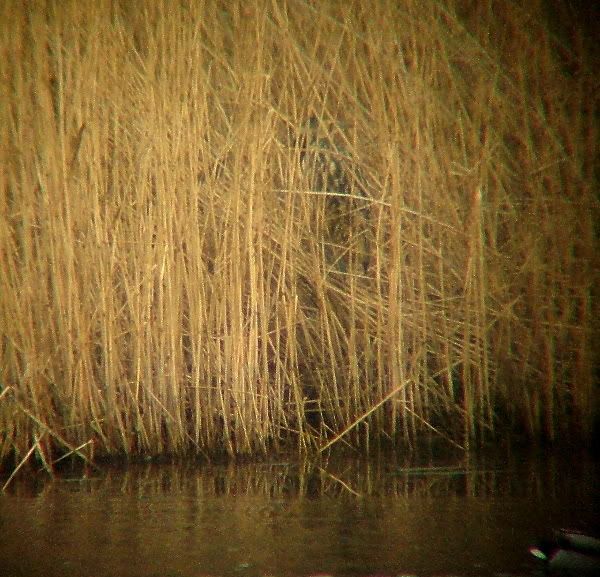 click to enlarge
click to enlargeLook close and look hard, look for the black markings on the back.
Potteric Carr, just south of sunny Doncaster, it's a big site, getting bigger, and full of birds. The star attraction here are Bittern. On any given day during the winter up to 6 birds are to be expected on the YWT reserve, and the neat part, as the staff was happy to tell me, is the they cut the edges of the otherview very thick reed beds fairly short, so you can see into the reeds a wee bit, which isn't done elsewhere. 'Best place in the country to see Bittern', he said. I could hardly disagree, we had three sightings through the day, of probably three different birds. They do not stay to breed on site yet, although there's no reason why they shouldn't soon begin to. Black-necked Grebe already do breed there (although are absent in winter), so that could be a fantastic spring/summer double in the future.
Our best view was when one Bittern flew right-to-left across Piper Marsh, which is apparently its uniform behaviour, as the bird circuits the reeds in a clockwise direction. The flight is far more direct than the languid wafting of Heron, they go much quicker than that. The tip I was given by the locals was look for the gulls to scatter from the water, as if in predator evasion mode, because they see the Bittern coming before we do and are bloody scared of it!
Run!
Other notables for the day included Water Rail - with ridiculously close views as they fed right out in the open under the bird table on Willow Marsh. That's a very good spot all round really, with 19 species on or around the feeders. As one might expect on a reclaimed northern industrial site, there were Willow Tits all over the place, Great Spotted Woodpecker, Bullfinch, and Jay, also showed well. There is a pair of the vastly declined Lesser Spotted Woodpecker around Potteric Carr, not to be seen during our visit though (nor since the previous Tuesday), indeed such difficult blighters are they to find that one report a week during the winter is about the going rate - and this is the best time of year to see them!
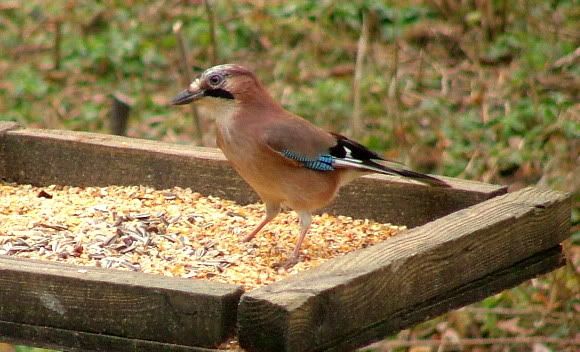
More videos of the day:
Video 1 - Dim distant Bittern preening, wait for the movement
Video 2 - Water Rail again
Video 3 - Jay
Labels:
birds,
birdwatching,
bittern,
doncaster,
jay,
potteric carr,
video,
water rail
Wednesday 19 December 2007
Sleek Bird

Just a brief update on yesterday's ABB event at Carsington. Top bird had to be the Great Northern Diver (which has been around since November 10th). That makes this the second successive year we've had the species present. Last winter 2 or possibly even 3 birds stayed, with GND present from November through to May. Pretty neat to have this bulky marine species. It'll have come from Iceland and in the cold half of the year really belongs around our northern coasts.
Otherwise notable were two Peregrine, as usual best seen perched on the towering electricity pylons.
Visitor numbers weren't great, but should hopefully rise at the weekend with the arrival of Christmas holidays. Memorable person of the day was the lady utterly in love with Wigeon, her genuine favourite she said. There's a Simon Barnes piece in today's Times about the duck which must go someway toward explaining why - read here.
Monday 17 December 2007
Willow Tits: On The Brink
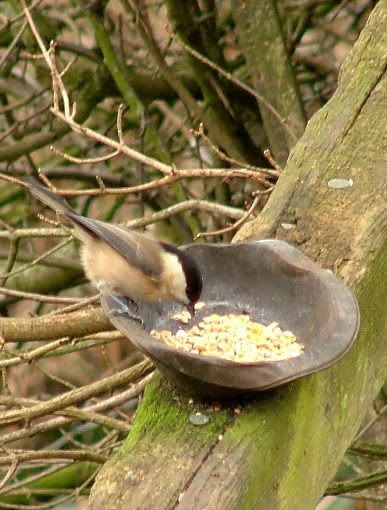 Quite a cold snap at the moment, so a good time to get out around my alternative local patch Brierley Forest Park and make sure the feeding stations are well stocked.
Quite a cold snap at the moment, so a good time to get out around my alternative local patch Brierley Forest Park and make sure the feeding stations are well stocked.Plenty out and about there, although the transient winter finch flocks, Redpoll and Siskin have moved on. Blackbird numbers are notably high with loose gatherings of 20 birds in several areas. Most gratifying birds to see, however, were Willow Tits, with 4 or 5 individuals congregating around the seed pots and hanging fat feeders.
The recent story of the Willow Tit is shocking both for the extreme decline in their numbers and for the lack of awareness of it. Just take a look at what happened to them in Kent. In 1996 there was estimated to be 500-900 pairs in the county, and now, it's probably none. There's a similar story over most of the south-east, East Anglia, much of Wales, indeed few are the regions in which they are not crashing or already extinct- Nottinghamshire/Derbyshire probably being their stronghold these days.
It may be that the very similar Marsh Tit, declined significantly itself since 1960's although probably levelling off now, provide the sort of ID confusion that lead birders to think there are Willows present in areas where they have lately disappeared from. The best way to tell between them is their call ( try listening at the RSPB website) - although even those can vary enough to be confused, and the slight plumage details aren't always sure fire either. General advice is to look for a slight wing-bar on the Willow Tit.
The national figures say it all really, a decline of 72% in the years 1994-2002, nearly three quarters gone in only eight years! Little wonder it was recently added to the Red List of species of greatest conservation concern.
There is still much debate over the cause of this catastrophic dip. The Willow Tit's weakness is its choosiness, only very wet young plantations of willow, birch and alder scrub, and occasionally pine, will do, so on sites where plantations are maturing, drying up or are being cleared of scrub, Willow Tits suffer quite badly. One influence on this change is the national boom in deer populations, Roe and Muntjac in particular will nibble away the undergrowth these birds rely upon. Coupled with general habitat loss to development and urban sprawl, and Willow Tits are running out of breeding sites.
The other theory that's given a lot of credence proves how difficult biodiversity can be to manage. Despite having an abominable 2007 when the heavy rains washed away all their caterpillar food, Blue Tits are generally on the increase in areas where Willow Tits are losing out. The evidence suggests to some that Willow Tits, the only tit species in Britain to excavate its own nest cavity, are muscled out of their territories and nest sites by the other tits. Mainly Blue Tits, but also Marsh and Great Tit will do this. Great Spotted Woodpecker are another additional pressure, as they will raid nests for chicks.
Studies are ongoing and we don't really have any answers just yet, and I'd suppose there won't be just one reason for the crash. I tend to wonder about the future and climate change. With dryer summers degrading their habitat further, more competitor species making it through milder winters, the future looks bleak for the Willow Tit, real into oblivion stuff.
Thankfully we still have them locally, chiefly due to all the old colliery sites around here that have been returned to nature and planted up in the last 20 years, sites such as Brierley.
They are also present at Carsington, and I'm volunteering there tomorrow. I just might begin adding Willow Tit to the conservation spiel I give to visitors.
Sunday 16 December 2007
Doubling Ducks
Seemed like a while since the girlfriend and I had been on a local twitch, leafing through my entries here is was the Rutland Red-necked Grebe in October, so it was due. A quick browse of Birdguides (where would birders like me be without such websites?), came up with a nearby Long-tailed Duck just across the county border in Derbyshire, at a LNR called Williamthorpe Ponds. Upon arrival it turned out to be quite the typical modern local nature reserve, a small pocket of wildlife much surrounded by Acme industrial complexes Ltd.
...when the duck eventually stopped diving.
This Long-tailed Duck (#204 for my life list) has been a long stayer, present on site since late November, and true to form there it was, a mucky looking 1st-winter drake, with a tail of diminutive standards. Still cute faced as ducks go though, rather round of head with the facial expression of a sated puppy. These guys ordinarily winter at sea, and are fairly common on our northern coasts, hence the local twitch value of this inland bird here in the East Midlands. Most LTDs seen around the UK will have come from the breeding populations in Iceland and Greenland where they nest on lakes and freshwater marshes, feeding largely on crustaceans, molluscs, and aquatic invertebrates, during which they dive for long periods.
Our bird seems happy where he is, and quite fearless of man. Just a little patience and views within 10 yards would come. A really nice bird.
As ever, just being out and about brings its own rewards, this time a wandering Water Rail. Icy days seem to encourage them out of the reeds and this one walked with a couple of yards of us, utterly oblivious. It made for quite the most memorable encounter, and I could hear others squealing in the reeds. Check the video links below.
Other birds around included the regular winter ducks, both common grebes, and I heard a Willow Tit or two.
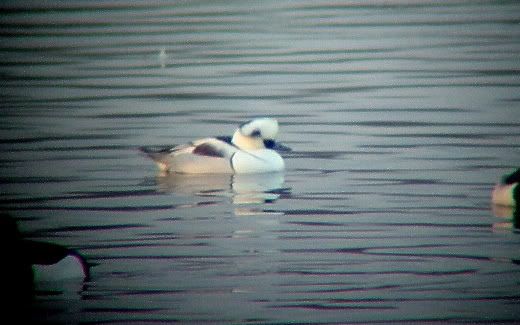 How cool?
How cool?The second scarce winter duck of the day was this gorgeous Smew back at one of my local haunts, Kings Mill Reservoir (you know it well by now if you read my bird blog), a neat stop off on the way home. Apparently only the fourth record for the site (check out the local recorder's website for more info), it drew in many a local birder, and happily a few non-birding passersby.
Winter males are always striking, for me their look harks of Walls vienetta, you know, that fancy white ice cream with the embedded wafers of chocolate. Historically Britain receives more wintering females than drakes, though I'm not so sure that's necessarily true these days, with around 200 mainly finding sites in the south-east, migrating from the lakes and rivers of northern Scandinavia and Russia where they breed. His diet mainly consists of small fish, larvae and invertebrates.
Winter males are always striking, for me their look harks of Walls vienetta, you know, that fancy white ice cream with the embedded wafers of chocolate. Historically Britain receives more wintering females than drakes, though I'm not so sure that's necessarily true these days, with around 200 mainly finding sites in the south-east, migrating from the lakes and rivers of northern Scandinavia and Russia where they breed. His diet mainly consists of small fish, larvae and invertebrates.
Friday 14 December 2007
The Roost of the Wagtails

Here's a surprise treat, something I discovered during my walk to the bus station, it's an urban Pied Wagtail roost, in Mansfield. I knew there was one around the town centre, and there it is, in the lone beech tree tucked behind the closed down Tesco. Noticeable first because about half an hour after sunset, when the wagtails descend from the surrounding buildings there's quite the cacophony, almost giving the impression of a pet shop aviary given the high street location.
Quite difficult to photograph in the gloom though, so here's a dodgy video of the action.
For ten or twenty minutes before the wagtails came down to roost they circled quite high, gathering their numbers and emitting that familiar 'chiswick' call. Rather like Starling, they appear quite nervous, unwilling to be the first individual to touch down. Eventually it happened, half a dozen birds flitted into the roost, and then came a continual flurry for the next twenty minutes, getting louder and louder.
Difficult to estimate the total number, but by the end perhaps 120 birds came in, give or take. A quick explanation of this behaviour is that the birds find safety in numbers during the night and choose these urban settings because the micro-climate in our towns and cities tend to be a couple of degrees warmer than their more rural surroundings. The roosts are often traditional sites, with one used for at least 30 years, and some can contain thousands of birds. The largest one I'm currently aware of in my part of the world is in the centre of Nottingham, with reports of 850 individuals joining the roost. I try not to imagine the kind of mess them must leave below them.

Neater still, as I photographed the scene, shoppers stopped to look and listen to the spectacle, a couple of them venturing to ask me what birds there were. 'Lovely', and 'I would never have thought', were the sort of things they were saying.
And what else to say, but again it's a bird triumph, they wowed us again!
In other news, the girlfriend and I enjoyed a night at the cinema this week, as we went to see the exceptional new French version of Lady Chatterley. I mention this for two reasons, it's full of birds, and, here's the terribly nerdy part, I spent moments during the film mentally noting the location errors - for example, we don't have Black Kite in this part of Nottinghamshire (I live where the story is set), despite the bird of prey depicted soaring over the woods. Heck, I really wish we had them!
Anyway, is it really, really, terribly sad to be noticing these things? Awful, I'm sure of it. I suppose that's how birders are, we never really switch it off.
That's all for now, but here's a couple more videos of the wagtail roost...
Video 1 - Wagtails
Video 2 - Wagtails
Video 3 - Wagtails
Labels:
mansfield,
Nottinghamshire,
pied wagtail,
roost,
urban birds,
video
Monday 3 December 2007
It's Dipperdale, surely?
 Isn't Britain wonderful? We're all of us in such easy reach of so many different landscapes. Over weekend the girlfriend and I picked out the unmatchable limestone beauty of Dovedale, on the Derbyshire/Staffordshire border. There was one bird, a favourite, that she wanted to see again, a species synonymous with Dovedale - the Dipper.
Isn't Britain wonderful? We're all of us in such easy reach of so many different landscapes. Over weekend the girlfriend and I picked out the unmatchable limestone beauty of Dovedale, on the Derbyshire/Staffordshire border. There was one bird, a favourite, that she wanted to see again, a species synonymous with Dovedale - the Dipper.Notice the blinking? Its eyelids look white or even silvery. That's called a nictitating membrane, somewhat like see-through eyelids or goggles by another name, which allow the bird to search for underwater food (mostly insect larvae, fresh water shrimp). Neat huh?
They also have a special preen gland and undercoating of feathers to keep them dry, and their blood is richer in oxygen than most other perching birds, all adaptations for a sub-aqua lifestyle.
I really doubt there is any place in the world where you can get closer views. The Dippers along this most popular stretch of the Derbyshire Dales barely register the presence of passersby, and with just a little patience you can be within feet of them.
The heavy rains of previous days made for a high river which perhaps explains why for our visit the Dippers fed almost exclusively duck-style, swimming and diving from the surface rather than skipping in and out of the fast waters around the rocks. For me it remains a bizarre sight, this bird not unlike a Blackbird, so at home on the water. Look...
By the way, I should probably explain that winter in the valley is really too dark to get decent still photographs, at least not with the primitive kit I carry. Far easier to instead record the day on video, even if it's only lo-res stuff. Most of these I digi-binned through my 8x42s.
So real crackers, one of those bold and brilliant birds complete strangers birders and bird novices alike, will stop, watch and talk to each other about. Top #10 British Bird for anyone's money.
Plenty else in the dale too though, dozens of Siskin and plenty of Nuthatch showed well in the car park, that universal companion of the Dipper - Grey Wagtail were just as numerous, Raven were a nice touch over the woods and again relatively decent views for such a shy species. Redwing, Treecreeper and Buzzard, kept things interesting away from the water.
Last bird of the day was a redhead Goosander on the river. She should probably think about moving down to a lake or reservoir for the winter.
There was more wildlife treat though, a bonus; stellar views of a Weasel foraging the river bank. You can never expect such a thing, but just by going out you win the occasional lottery and there it'll be. Memorable stuff.
The Goosander.
A couple more video links:
Dipper 1
Dipper 2
Last word, be careful on the stepping stones and think twice about crossing them in winter. We saw one accident with a mother and her kids ending up on their bottoms in the water, and it was only luck really that we had a blanket and spare coat to lend them from our car.
This isn't the time of year to be getting wet folks.
Monday 26 November 2007
General Update
It may be cold outside at the moment, still the ABB days go well at Carsington. Tuesday was all about the schools really, with three classes through and genuine wide-eyed excitement from plenty of them. Who knew primary school aged girls could get so excited about Lapwings? It's great!
If you're a birder, go on, give volunteering a go!
43 species from the Wildlife Centre on Tuesday, then a slightly above average 50 on Sunday, means we always have something to show people. Highlights have perhaps been the Siskin with at least ten birds around. Two Dunlin, Snipe and Redshank keep things interesting wader-wise, and for the raptors Peregrine, Buzzard, Sparrowhawk and Kestrel do well for the side. A few other species moving around too, Great Spotted Woodpecker and Treecreeper notable visitors at our end of the big water.
Duck (mainly Tufted and Wigeon) and Lapwing numbers are down though, more than halved in the last few weeks. Perhaps they are dispersing to smaller local sites.
The only personal disappointment is not being able to reach the other end of the reservoir before dark once the hubbub has died down. A Ring-billed Gull is regularly coming in to roost on one specific island, reported at 15:30 practically everyday, a sure thing all the way from North America.
Ah well, stumbling down the paths in the twilight I did pick up a Tawny Owl swooping down onto the prey in a field nearby a known roosting tree. Rare sight of a common, if secretive, bird, so I'm happy.
If you're a birder, go on, give volunteering a go!
43 species from the Wildlife Centre on Tuesday, then a slightly above average 50 on Sunday, means we always have something to show people. Highlights have perhaps been the Siskin with at least ten birds around. Two Dunlin, Snipe and Redshank keep things interesting wader-wise, and for the raptors Peregrine, Buzzard, Sparrowhawk and Kestrel do well for the side. A few other species moving around too, Great Spotted Woodpecker and Treecreeper notable visitors at our end of the big water.
Duck (mainly Tufted and Wigeon) and Lapwing numbers are down though, more than halved in the last few weeks. Perhaps they are dispersing to smaller local sites.
The only personal disappointment is not being able to reach the other end of the reservoir before dark once the hubbub has died down. A Ring-billed Gull is regularly coming in to roost on one specific island, reported at 15:30 practically everyday, a sure thing all the way from North America.
Ah well, stumbling down the paths in the twilight I did pick up a Tawny Owl swooping down onto the prey in a field nearby a known roosting tree. Rare sight of a common, if secretive, bird, so I'm happy.
Labels:
abb,
Aren't Birds Brilliant,
birding,
carsington,
Derbyshire,
RSPB,
volunteering
Sunday 18 November 2007
My Little Auk
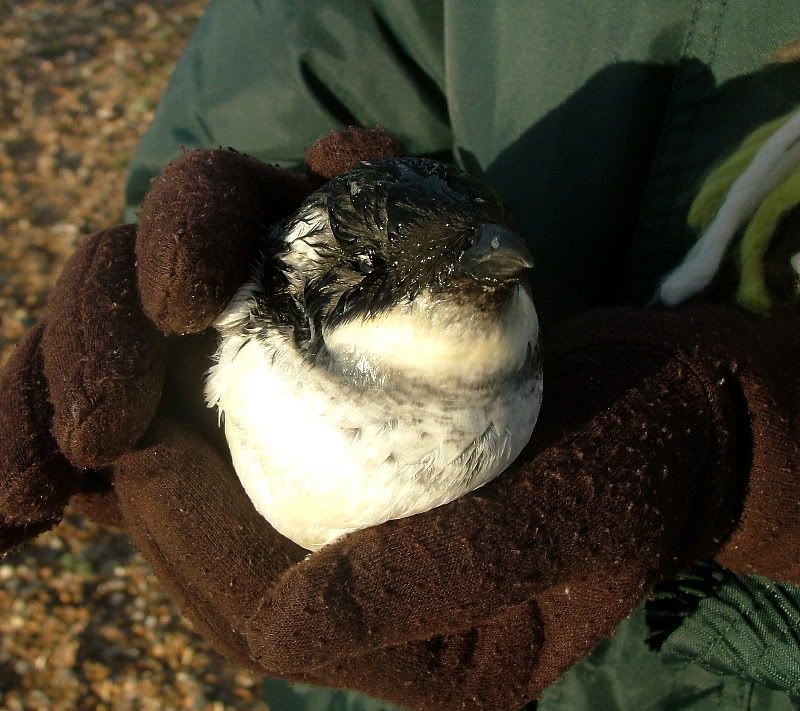
So the the saga of the Little Auk. I take you back to Monday before last, a cold and blustery wintry morning at Snettisham, masquerading as November 12th. The ongoing Little Auk wreck (following the deep North Sea depression that had battered if not quite lacerated through the North Norfolk coast with a strong tidal storm surge) was taking place further east, so we weren't quite expecting to find any. Oh but we did. First sighting came with four bobbing around in the high tide, only a few feet from the shore. Lovely squat birds, sort of bullet-shaped, and for all my bird knowledge they still looked like fresh chicks. Of course they weren't.
A nice lifer then, but onward back to the pub for the &B part of our bed and breakfast weekend.
The walk back to the car park at Snettisham takes anywhere between 30 and 50 minutes depending on how many times the birds stop you, and stopped we were by another Little Auk, this time on the lagoon behind the holiday huts. This time something was wrong, the bird paddled weakly and as we stood to watch, it slowly but inevitably floated into the horrible foam on the windblown side of the water.
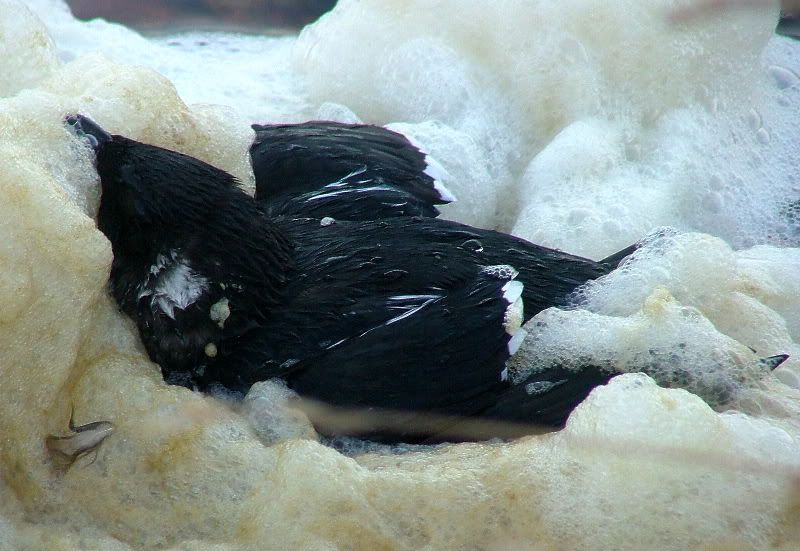
It was stranded, rolling in this froth, utterly stuck. Now usually I'm not one to intervene; Magpies I'm perfectly happy to have them as a garden visitor and when the Sparrowhawk takes one of my Blackbirds I'm actually quite thrilled - it's like a David Attenborough film outside your kitchen window. This time, clearly leaving things be wasn't going to be satisfactory, this birds, its dignity, it deserved better.
Glad for my gloves I scooped it up and rushed the damp fella back over the seawall to the beach, in hopes of refloating him. In retrospect it was never going to happen, and after a few feeble efforts the slosh of the sea's motion grounded the bird again.
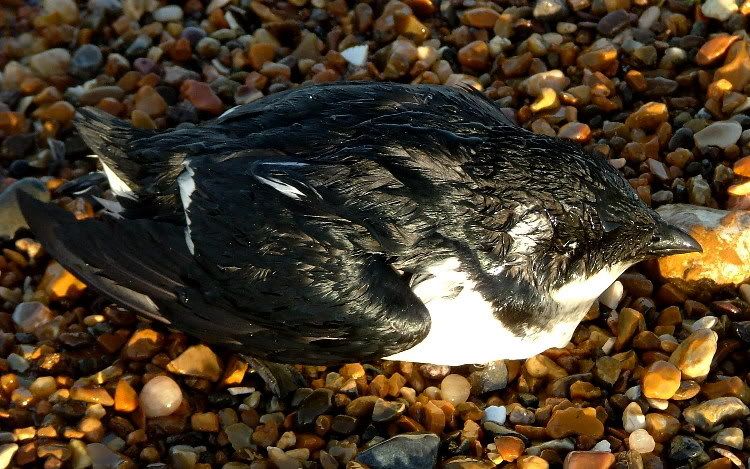
Settling on the conclusion that it was likely to die, we reasoned that the best thing to do would be to rest the bird back down on the bank of the lagoon, this time on the sheltered sunny side. If was to die at least it was somewhere quiet, and sadly die it did, as we discovered after returning from our breakfast. The bird was never very lively, in truth it wasn't only exhausted but water-logged too.
Elsewhere in the country I'm sure similar stories are being recited, with almost 30,000 Little Auks past the Farne Islands in one day, and individuals blown as far inland as Doncaster, it's clear this was quite the birding event of the autumn this year in Britain, a lot of birders happy for the tick and I'm sure plenty of grateful gulls were happy to gobble the weakened auks down whole.
There will be a lot of discussion over why this occurred, was it just the storm pattern that pushed the auks so far south or could it be something more worrying like climate change induced disturbance of their marine food source? Likely to be both I would suppose.
The smallest of the auks (about the size of a Starling but much heaiver - believe me!), this species does come closer to shore in winter than its larger cousins, although for the large part they'll stick to the open ocean, the North Sea, the Atlantic and as far north as the Arctic ice shelf. They live for upto 10 years, perhaps a good deal more, and feed chiefly on plankton, invertebrates and small fry.
A lifer for us then, a life diminished too, and a bird held in the hand that quite probably came from a Spitsbergen breeding colony, a good deal north of the Norwegian mainland, from one of the nests not plundered by a Polar Bear. Memorable stuff from our hobby yet again.
link - an article in the Independent about this Little Auk wreck
Labels:
birding,
birds,
little auk,
Norfolk,
RSPB,
rspb snettisham,
Snettisham
Thursday 15 November 2007
Birds On a Bigger Scale
It's Thursday and I'm still tired from the weekend, but what a weekend!
For our autumn getaway I promised my girlfriend we'd go find a true birding spectacle; the great goose and wader flocks of the Wash. The destination was easy enough to pick, it had to be Snettisham RSPB reserve.
From Saturday through Monday we visited the reserve each morning (5:30am starts - ouch!) and twice in the evening, I suppose we just couldn't get enough. We were lucky on several counts, firstly because the Pink-footed Geese came down to their British wintering grounds earlier than is usual this year so the flocks flying from and to their roost were at their probable maximum, around 40,000 birds, perhaps more - you begin to guess with so many birds.
Morning seemed the best time to watch them going over because they leave in good light, whereas it was upto an hour after sunset when they flew into roost on the mudflats. The whole thing lasted over 30 minutes, with numerous skeins leaving almost all the time for the fields inland, mostly to nibble on left over roots of post-harvest sugar beet and potato crops, as apparently farmers are encouraged to leave a little something for them. That's why they gather in Norfolk in numbers you just wouldn't have seen a few mere decades ago.
The other bird that are around Snettisham in big numbers are of course the Knot, with a roost of around 10,000 birds covering the islands and banks of the lagoon behind in the dunes. The mass of greyness almost looks like a large patch of gravel at a distance. They are only in during high-tide so that meant for our visit we missed them gathering but were able to watch them depart at daybreak. Sort of a double spectacle with the geese going over at the same time.
In among the roost were occasional interlopers, a few Bar-tailed Godwit, Dunlin and Redshank on the edges of the huddle. Once the Knot went, that was it, whoosh and everything snaked over out onto the mudflats, leaving us with a few Dabchicks and Goldeneye left on the water, as well as a couple of hundred lazy Oystercatchers. It was exciting watching, waiting, for that moment of grand départ.
Other birds of note at Snettisham were a nice Barn Owl hunting in the pre-dawn gloom (ask for your money back if you go to Norfolk and don't see one), a couple of Merlin winged through on the wind, similarly a Great Skua was around, a few flushed Red-legged Patridge, and of the passerines a few Fieldfare battled the gusts, as well as Skylark, Meadow Pipit, Linnet and a Stonechat around the car park. On the mudflats, a good typical mixture of Golden Plover flocks, solitary Grey Plovers, lots of Dunlin, Curlew, Turnstone and Sanderling, a handful of Avocet. As well as the Pinkies wildfowl-wise there were also plenty of Greylag, Brent and Canada Geese, Shelduck, surprisingly large numbers of Mallard, and the one Scaup went through too.
On our final morning at the reserve, something rather special occurred, we found Little Auk bobbing in the high tide just off the beach, part of the Great Little Auk Wreck of '07. It began with 4 of them, but that was just the beginning of the story. More about that in another entry though, and the other sites we dotted along the coast last weekend, as well as more videos.
Gravel?
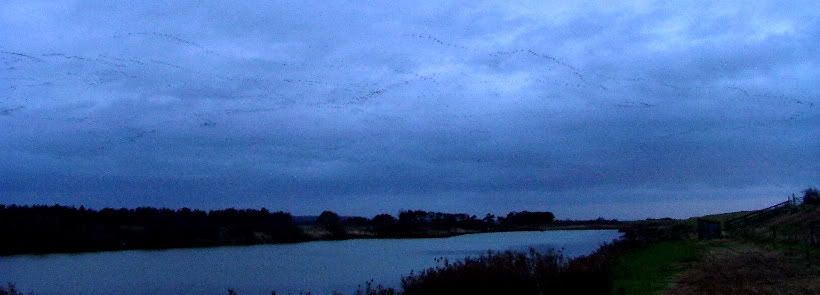
Labels:
flocks,
knot,
little auk,
Norfolk,
pink-footed goose,
rspb snettisham,
the wash
Thursday 1 November 2007
One New Bird Fan
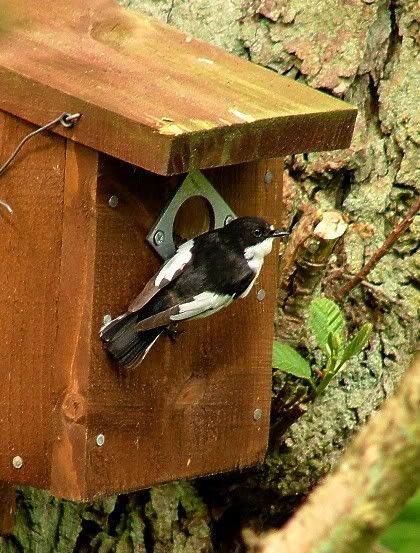
So I was baby-sitting my niece today, she's two-and-a-half, a cracking age for having fun, and in the midst of the day something catches her eye on the computer as it flicks through on my screensaver gallery. It was this shot of a Pied Flycatcher at Coombes Valley RSPB. She asks with no small puzzlement, "What's that birdie doing on that 'ole?"
I explain it's a daddy bird and his babies are keeping safe inside the box, and that he takes food to them there. She asks me what his name is and I try to get across that they're called flycatchers. Anyway, her conclusion to all this new information, "It's cute!"
She's hardly wrong and you know what, I think we might have snagged her already!
For Birds, For People, For My Niece!
Sunday 28 October 2007
Feed the Birds Day
Yesterday's events went well, Carsington again, this time Aren't Birds Brilliant x Feed the Birds Day, so all very busy and records broken for the number of names and addresses going into our visitor book. The girlfriend did a spot on job catching folks before they could leave the Wildlife Centre. She's the friendliest person in the world, you'd be a cold cold person to tell her you're not interested.
Bird-wise, highlight of the day had to be the Red-necked Grebe early on. It showed well for a while, even sailed close to a Dabchick for the ultimate comparsion and confirmation. Shame then that it was pushed away so early by a fisherman's boat, as it was never again seen for the rest of the day. Later I read a peeved comment in the log book of a hide further around the water noting how a number of fisherman had forced everything up the other end of the water. I'd feel uncomfortable about complaining though, the Severn Trent rangers do such a good job otherwise. It is the way of life that we should share reservoirs with other interests.
The other top notch bird was the Peregrine, with a spectacular display in front of the centre. First it sat sedately atop a distant electricity pylon, surveying the scene, and then action, the hunt. Off it took, all wildfowl scattered for dear life, and in came the Peregrine all muscle and streamlines, first stoop for a Lapwing - a miss, second for a Coot on the water - another miss, and back to the pylon. I kick myself now, but it was lunch break and I needed the loo. Of course, I come back later and learn it took a probable Teal right off the island in front. Damn!
Again, back to the pylon went the Peregrine to devour its catch, where we could show visitors the grizzly aftermath. The falcon is a steady show, at the moment you'll see one most days, and I'm glad because it's a good bird to talk to visitors about - fastest animal on earth and all that. One boy utterly agog at the 200mph stuff.
At the end of the day and in pouring rain, we drove to the Sheepwash car park to check up on a reported Black-necked Grebe, thinking how neat it is to say you saw 4 species of grebe in the day. To no avail (although I read one has been reported today) though, and instead we scored a Yellow-legged Gull, a 3rd-year bird - looks almost adult except it still has dirty pink legs and the black wing-tips are very large in flight - pictures below and very dark video here. Very languid it was too, lazy flight in amongst the busy flapping Black-headeds.
And the last to come in were at least 500 Jackdaw, perhaps many more, as big a flock as have ever seen, noisily commuting over Hall Wood.
 Yellow-leg...
Yellow-leg... ...with cormorant.
...with cormorant.Edited to add: Seems there has been some confusion with the grebe. To confirm on my part, I'm confident we had a Red-neck in the morning - the only question was over the fairly dark bill - which could suggest an autumn Slavonian, although bird club member with us confirmed Red-neck as suggested by the heavy bill and build of the grebe. Later in the day, we also had a visitor requesting ID help on a probable Black-necked Grebe he saw at the other end of the water, which he seemed certain had no reddish/warm at all, unlike the earlier bird. Then today, we have reports of a Slav Grebe!
So how many birds at we talking about here? 1, 2 or 3? Who knows? Seems unusual for all three to turn up like that. Two? Maybe. I may now get down to the ABB event on Tuesday, check for my own peace of mind the reported Slav, should it stay, isn't the bird we had on Saturday. Moulting autumn grebes, bigger headache than you'd think!
So how many birds at we talking about here? 1, 2 or 3? Who knows? Seems unusual for all three to turn up like that. Two? Maybe. I may now get down to the ABB event on Tuesday, check for my own peace of mind the reported Slav, should it stay, isn't the bird we had on Saturday. Moulting autumn grebes, bigger headache than you'd think!
Wednesday 24 October 2007
Starlings!
Stick with it, eventually they descend into the reeds.
Just a snippet of an entry, a video of the Starling roost at one of my local patches, Kings Mill Reservoir. Perhaps only 250 birds and yet still a display worth getting away from the TV to go watch. Amazing how they all coordinate to form such dynamic flocks. There's some insight from a study (here) in Rome that goes some way to explaining the phenomenon. Lots of techno-babble in there, but the gist seems to be that each individual bird orientates itself against only the handful of other birds around it. Multiply that by a thousand or a million and hey presto, one of the more remarkable behaviours to be found anywhere in the natural world.
Speaking of Starling roosts, I'm at Carsington at the weekend, not only will it be an Aren't Birds Brilliant event, we have Feed The Birds Day too(!). At the end of the day in the autumn/winter months there's a significant roost in a nearby village called Kirk Ireton, of upto 100,000 birds. No news on it yet this year, so perhaps I'll go have a look for myself.
Labels:
birding,
birds,
kings mill reservoir,
Nottinghamshire,
starling,
starling roost,
video
Monday 22 October 2007
Relishing Rutland
Yesterday the girlfriend went down south on business again, giving me chance to get dropped off at Rutland Water and picked up again at the end of the day. Always worth a visit, I didn't find any of the rarer grebes from last time, but I did bag a new lifer, a Goshawk (#203).
The raptor was distant enough to make a glimpse through binoculars suggest Buzzard on size alone, no doubting a Goshawk though when I located it on the scope. Certainly big, all pale below, long in the tail, with fairly broad-tipped wings of not the hugest span (ruling out Peregrine as a contender). Finally some strong slow wingbeats confirmed it was a bird of substance, not an unusually big looked Sparrowhawk - which are much more prone to a weak flapping action when they soar.
Alas, a quick glance around the hide showed only novice birders with no scopes, so I concentrated on confirming ID for myself rather than spreading the news and the Goshawk, always faraway, soon sailed off into the distance over the Hambleton peninsula. Ultimately the find was a bit like the difference between a Carrion Crow and Raven; for all the smaller crows or hawks you check, you just know almost instantly when you've finally found the bigger, more impressive bird.
Not so sure Goshawk are much of a fixture at Rutland, but the great mix of habitat shouldn't make it too surprising I would suppose, especially at this time of the year when some of the birds spread to more open country.
Anyway, I'm chuffed - an unforeseen lifer!
Elsewhere around the reserve it was very quiet for a Sunday and I had many hides all to myself. That way I could sit silently and patiently and got some terrific views of Kingfisher and Water Rail, and in one a Wren sat on the ledge next to me. One of those seldom occasions you find a tick inside the hide. It sure cursed at me too. I was alone but I still smiled, I still laughed to myself, that's what birds can do to you. They're all a gift, a pleasure so often coming with the unexpected and this feisty wee Wren being no different.
I haven't posted a day list for a long time so here's the score for yesterday:
1. Barn Owl (heard)
2. Blackbird
3. Black-headed Gull
4. Blue Tit
5. Bullfinch
6. Canada Goose
7. Carrion Crow
8. Chaffinch
9. Collared Dove
10. Common Gull
11. Coot
12. Cormorant
13. Dunnock
14. Egyptian Goose (2)
15. Fieldfare (c.50)
16. Gadwall
17. Goldcrest
18. Golden Plover
19. Goldeneye (c.20 my first of the season)
20. Goldfinch
21. Goshawk (briefly circled high over the peninsula)
22. Great Crested Grebe
23. Great Tit
24. Green Sandpiper (5+)
25. Green Woodpecker
26. Greenfinch
27. Grey Heron
28. Greylag Goose
29. Herring Gull
30. House Sparrow
31. Jackdaw
32. Jay
33. Kestrel
34. Kingfisher
35. Lapwing
36. Lesser Black-backed Gull
37. Linnet
38. Little Egret
39. Little Grebe
40. Little Stint (2)
41. Long-tailed Tit
42. Magpie
43. Mallard
44. Meadow Pipit
45. Mistle Thrush
46. Moorhen
47. Mute Swan
48. Pheasant
49. Pied Wagtail
50. Pintail
51. Pochard
52. Redshank
53. Redwing
54. Reed Bunting
55. Robin
56. Rook
57. Ruddy Duck
58. Ruff
59. Shoveler
60. Snipe
61. Sparrowhawk
62. Starling
63. Stock Dove
64. Stonechat (at least 6)
65. Tawny Owl (heard being mobbed by crows at 18:30)
66. Teal
67. Tree Sparrow
68. Treecreeper
69. Tufted Duck
70. Water Rail (good views of 3 from quiet hides nobody else stopped to look from)
71. Wigeon
72. Woodpigeon
73. Wren (one of which flew inside the Harrier Hide)
The sort of list that describes the broad variety of habitats they have at Rutland Water.
The girlfriend was late in picking me up, one whole hour late actually, so I was stranded in the dark for a while. No complaints from me as along the path I found a Tawny Owl getting grief from a pair of crows, and the tell tale shrieking of a Barn Owl.
Some pictures from the day:
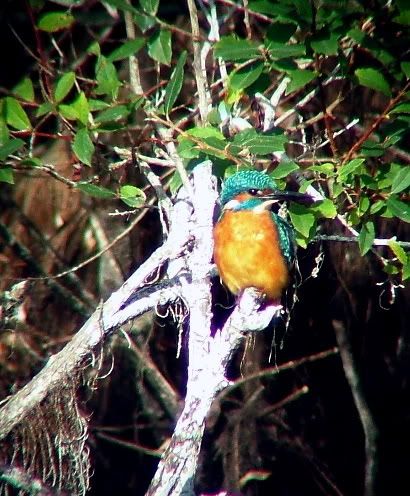 Kingfisher
Kingfisher Green Sandpiper
Green Sandpiper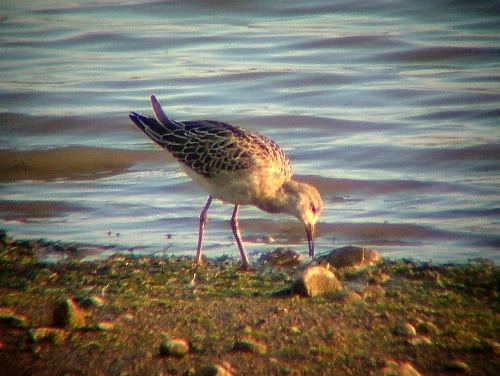 Ruff
Ruff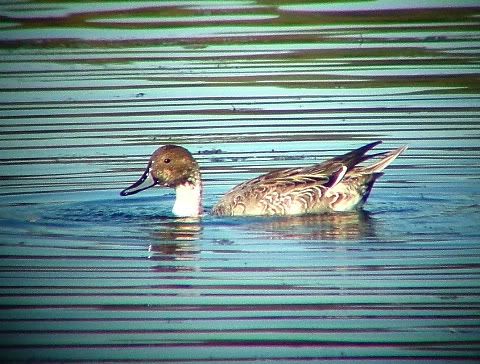 Pintail
Pintail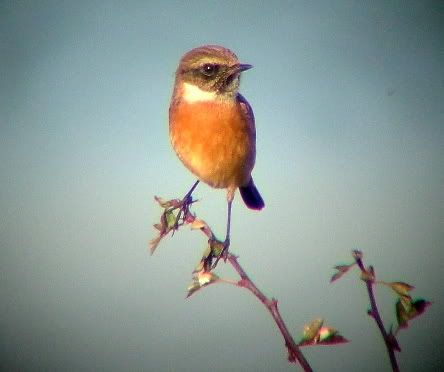 Stonechat
Stonechat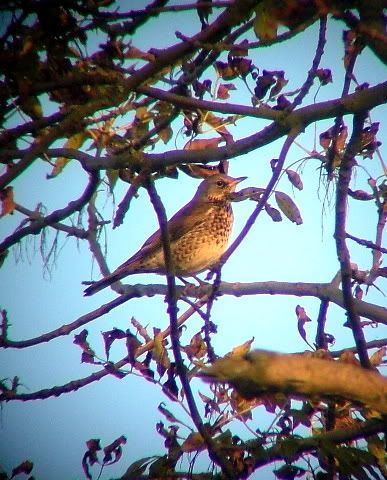 Fieldfare
Fieldfare(All taken through my 8x42s.)
You know, you could do a lot worse than spend a whole day watching birds.
In other news, my mobile phone has given out on me after a noble effort lasting almost 10 years, and I just whacked in a new ink cartridge in my printer. Why do I mention this? The RSPB are still collecting both for recycling/fundraising - the weblink - be sure to keep it in mind.
In other news, my mobile phone has given out on me after a noble effort lasting almost 10 years, and I just whacked in a new ink cartridge in my printer. Why do I mention this? The RSPB are still collecting both for recycling/fundraising - the weblink - be sure to keep it in mind.
Labels:
birds,
birdwatching,
digi-binning,
digibinning,
fieldfare,
goshawk,
green sandpiper,
kingfisher,
photography,
pictures,
pintail,
recycling,
RSPB,
Ruff,
Rutland,
rutland water,
stonechat
Wednesday 17 October 2007
Pinkies
Just booked a weekend away in Norfolk for mid-November, staying at a place right on the doorstep of the RSPB's reserve at Snettisham. The B&B was a bit steep, but you gotta do the wader roost sooner or later.
Quiet times otherwise, the ABB events are going nicely at Carsington. The Little Owls failed to show at the weekend, however a Kestrel blessed us with about two hours spent sat on the camera pole in front of the wildlife centre. That meant I could prattle on about how the Kestrel's ability to see ultraviolet light allows them to track the urine scented trails of the small rodents they prey on (more on that here), which seemed to particularly impress the visitors I spoke to.
Bird of the day, or birds shall we say, was the 150+ Pink-feet that flew over around one in the afternoon, heading SE. This is apparently a little late, as the bird club report for September explains, "southward records are usually 2hrs after first light, which is the flight time from the Lancashire feeding grounds of Marshside and Martin Mere. Their northward journey is usually at least 4hrs after first light Jan-Mar, reflecting the hundred miles from Norfolk".
Later still, on the way home the girlfriend and I stopped off for a quick scan of Ogston Reservoir. It was there at 17:35 came a lone grey/brown goose, not a Greylag, another Pinky! Must have been a straggler. Isolated and nervous, it made several low passes over the water though never with the confidence to land, and bizarrely made three attempts to merge with 200 airborne Lapwing, presumably such was the bird's instinct to flock.
Eventually, I lost sight of it as the gloom of the autumn evening set in.
Can hardly wait now for Norfolk, it'll be the same geese, but by the tens of thousands.
ETA: Incidentally, the Gannet mentioned in my last post, the one I missed by half an hour or so at Carsington. I read that on Monday this week a juvenile Gannet (surely the same bird this far inland), was discovered and taken into care in Mansfield, less than a couple of miles from my home. What a tease that bird has been for me!
Good to know it'll be looked after now.
Quiet times otherwise, the ABB events are going nicely at Carsington. The Little Owls failed to show at the weekend, however a Kestrel blessed us with about two hours spent sat on the camera pole in front of the wildlife centre. That meant I could prattle on about how the Kestrel's ability to see ultraviolet light allows them to track the urine scented trails of the small rodents they prey on (more on that here), which seemed to particularly impress the visitors I spoke to.
Bird of the day, or birds shall we say, was the 150+ Pink-feet that flew over around one in the afternoon, heading SE. This is apparently a little late, as the bird club report for September explains, "southward records are usually 2hrs after first light, which is the flight time from the Lancashire feeding grounds of Marshside and Martin Mere. Their northward journey is usually at least 4hrs after first light Jan-Mar, reflecting the hundred miles from Norfolk".
Later still, on the way home the girlfriend and I stopped off for a quick scan of Ogston Reservoir. It was there at 17:35 came a lone grey/brown goose, not a Greylag, another Pinky! Must have been a straggler. Isolated and nervous, it made several low passes over the water though never with the confidence to land, and bizarrely made three attempts to merge with 200 airborne Lapwing, presumably such was the bird's instinct to flock.
Eventually, I lost sight of it as the gloom of the autumn evening set in.
Can hardly wait now for Norfolk, it'll be the same geese, but by the tens of thousands.
ETA: Incidentally, the Gannet mentioned in my last post, the one I missed by half an hour or so at Carsington. I read that on Monday this week a juvenile Gannet (surely the same bird this far inland), was discovered and taken into care in Mansfield, less than a couple of miles from my home. What a tease that bird has been for me!
Good to know it'll be looked after now.
Labels:
abb,
birding,
birds,
carsington,
geese,
Ogston,
pink-footed goose,
pinkies,
RSPB
Saturday 13 October 2007
Carsington by Bike
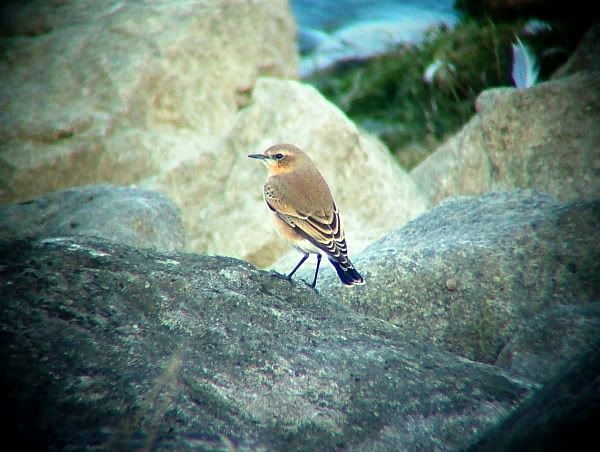
Another free Friday, and more laps around Carsington. Dropped off by the girlfriend I arrived early and promptly spent a couple of hours at the wrong end of the water. Only later when cycling the other side did I learn from the head ranger (evidently doing a TV interview I fear I may bungled into, whoops, sorry and take 2!) about the Gannet that was seen off the fisheries office in the morning. Presumably the same juvenile seen much of the week up on Howden Reservoir in the north Peak District, and that turned up today at Carr Vale NR on the Derbys/Notts border. If we're talking about the same Gannet you must wonder how much longer it can keep wandering like this so far inland. I do hope somebody finds the bird should it exhaust itself. That happened locally with an adult bird a few years ago that ended up crash-landing in some lucky punter's back garden. Just try to imagine...
For the rest of the day I picked up the regulars, a male Red-crested Pochard approaching prime plumage after his moult napped in front of the wildlife centre, Buzzards were all over the place, the Little Owl kept to their routine - showing well around the fence posts until disappearing around two in the afternoon, and I did briefly glimpse my first Green Woodpecker at the site.
And the Cackling Goose is back along with a maximum 42 feral Barnacles.
To explain, Cackling Goose is now used at the catch-all term for the species and subspecies of 'Lesser' Canada Geese. So the larger form we're all familiar with are signified as 'Canada Geese' and they originate from within the continental US and Canada, whilst the smaller which in the wild breed on the arctic tundra of the far north of Canada and Alaska are 'Cackling Geese'. For both large and small forms there are several different races, each with their own name, but all ultimately falling under either one or the other of the previous two categories. Got it?
As if to slightly confuse matters more, the goose at Carsington is of the 'minima' race, the smallest variant, which was called Cackling Goose all along anyway.
At the end of the day I rode to and fro along the dam wall to see what would turn up. A good number of Pied Wagtails for the most part, perhaps 50, about half that number of Meadow Pipits, a few Goldfinch and one Wheatear.
Finally, I've figured out how to get the best out of my digi-cam binocular combo, I suppose digi-binning, for want of a better term, hence the shot at the top there.
Labels:
bike,
birding,
birdwatching,
cackling goose,
carsington,
Derbyshire,
gannet,
lapwing,
red-crested pochard,
wheatear
Monday 8 October 2007
Try the Quiet Road
Goldfinch at Rutland Water
Business took the girlfriend south this weekend, so I tagged along to scour bird site down there I've seldom visited.
She dropped me off at Little Paxton mid-morning, giving me just enough time to get around the northern half of the reserve there. The site is made up of a network of older flooded pits and the current sand and gravel workings. Unlike many destinations Autumn isn't really the time to go; in Spring/Summer Little Paxton is famed for its Nightingales (28 singing males in 2006) and in Winter its a good site for migrant ducks like Smew and Goldeneye. So on my visit it was 'quiet', precisely the word used by the chaps doing the WeBS count that morning. I could have saved them their time, Wigeon, Wigeon and more Wigeon, write that down!
I did pick up a few Redwing, Meadow Pipits, Pintail and a Herring Gull, for a list that hardly broke 30 species. There were better birds around, a Little Stint elsewhere on the southern side of the reserve, a place I'll know to look in future.
Time came to head back northward and we detoured to Rutland Water, keen chiefly to find better views of the juvie Red-necked Grebe from last weekend. True enough it was fishing along the same shore, almost doing circles around a paddling fisherman, still far off but in better light. It looked a touch smaller than I imagine, quite significant compared to the GCGs. Also out there was a pair of winter plumage Black-necked Grebe conducting what looked like partial courtship display - head-flicking and synchronised diving.
The sandpipers of last weekend were all gone, indicating what a small window of opportunity migration is for picking up species like Curlew Sandpiper, and otherwise the most notable presence were the 8 Little Egret gathered on an island in front of the Egleton visitor centre. Will they stay for the winter?
Finally on the drive home we meandered through minor farm roads back to the A1, hoping to spot something from the car on the way, and we did. In a freshly ploughed field just south of the RAF base at Cottesmore a flock of 20+ Red-legged Partridge came into view.
Video 1 - Run Partridge Run!
Video 2- Very distant fuzzy Black-necked Grebe
As for tomorrow, I'm at Carsington for another ABB! event and, lord, does the weather look awful. The weatherman, he talks about inches of rain.
The Carsington Circuit
A warm autumnal Friday, lots of free time, I finally took the chance to push out a few laps of Carsington Water on my bike. The ride is lovely, if difficult in places, especially around the Hall Wood area where I just struggled over the hills on the bottom chain all the way. Buzzards and Ravens nested on that hillside and are still knocking around, probably most easily found viewing from the bird hide across the other side of the water.
The Little Owls showed in the morning, I caught 5 Buzzards over the wood, and discovered a second Stonechat on the dam wall, this time a male who'd do well to find the female showing well at the other end of the reservoir. Waders were thin on the ground, only 1 Dunlin right at the end of the day to go along with the always comforting numbers of Lapwing.
My one grumble is that I can't fit my scope on the bike. With only my binoculars I felt ornithologically denuded, and had to request another birder (with scope) to check that gull on the spit - Herring it turned out, not Yellow-legged.
It was a reminder just what an enormous difference a scope can make for your birding experience. Haven't got one? Save and up buy!
The Little Owls showed in the morning, I caught 5 Buzzards over the wood, and discovered a second Stonechat on the dam wall, this time a male who'd do well to find the female showing well at the other end of the reservoir. Waders were thin on the ground, only 1 Dunlin right at the end of the day to go along with the always comforting numbers of Lapwing.
My one grumble is that I can't fit my scope on the bike. With only my binoculars I felt ornithologically denuded, and had to request another birder (with scope) to check that gull on the spit - Herring it turned out, not Yellow-legged.
It was a reminder just what an enormous difference a scope can make for your birding experience. Haven't got one? Save and up buy!
The pictures; Rabbits in front of the Wildlife Centre.
Rabbits in front of the Wildlife Centre.
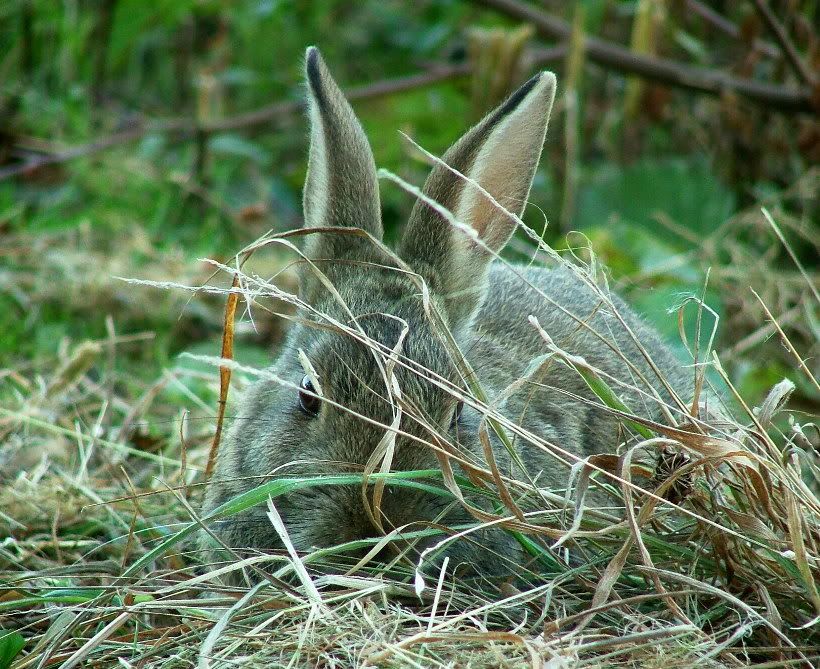
 They do thrill the visitors.
They do thrill the visitors.
 A sign of success?
A sign of success?
 The control tower. About 90m tall and accessed only by tunnels. All the water entering and exiting Carsington goes through it. When really fired up, the extraction rate is powerful enough to create a current in this very large reservoir.
The control tower. About 90m tall and accessed only by tunnels. All the water entering and exiting Carsington goes through it. When really fired up, the extraction rate is powerful enough to create a current in this very large reservoir.
 The long in the day Stonechat.
The long in the day Stonechat.
 Peace.
Peace.
 Rabbits in front of the Wildlife Centre.
Rabbits in front of the Wildlife Centre.
 They do thrill the visitors.
They do thrill the visitors. A sign of success?
A sign of success? The control tower. About 90m tall and accessed only by tunnels. All the water entering and exiting Carsington goes through it. When really fired up, the extraction rate is powerful enough to create a current in this very large reservoir.
The control tower. About 90m tall and accessed only by tunnels. All the water entering and exiting Carsington goes through it. When really fired up, the extraction rate is powerful enough to create a current in this very large reservoir. The long in the day Stonechat.
The long in the day Stonechat. Peace.
Peace.
Labels:
bike,
birding,
birds,
carsington,
Derbyshire,
rabbits,
stonechat
Wednesday 3 October 2007
Lend your name
No pictures or stories, instead a couple of petitions for you good people who've found my bird blog today.
First, the RSPB's Safeguard our sea life campaign;
First, the RSPB's Safeguard our sea life campaign;
"The seas around the UK's coasts are increasingly overfished, over-trafficked and over-developed, but crucially under-protected. Our precious seas are dying from neglect. Your support today will help safeguard our sea life."
"This cruel method is specifically banned by the European laws because is also massive, non-selective and impossible to control properly.
In the name of "tradition" the hunters use electronic appeals and hundreds of thousands of thrush migrating from northern Europe, and about 30% of protected birds, are attracted to glued trees, in closed “barracas”, and killed in the Ebro area between October and November.
In the same law-project the Catalan government is also trying to legalize a kind of net-trap hunting called "filat", which consist in trapping the thirsty birds attracted by small water pools, also forbidden in Spain, non-selective and impossible to control.
The protection of the nature performs all over new attitudes, but our government “of progress and ecologist” is of looking to a past of survival hunting that destroys protected species.
Please sign up in the campaign against this legalization and send this mail to interested people.
Our birds are your birds."
Follow this link to find out how to sign the pledge to Gordon Brown.
And a Spanish based campaign affliated with Birdlife International against plans by the Catalan government to legalise hunting birds with glue;
And a Spanish based campaign affliated with Birdlife International against plans by the Catalan government to legalise hunting birds with glue;
"This cruel method is specifically banned by the European laws because is also massive, non-selective and impossible to control properly.
In the name of "tradition" the hunters use electronic appeals and hundreds of thousands of thrush migrating from northern Europe, and about 30% of protected birds, are attracted to glued trees, in closed “barracas”, and killed in the Ebro area between October and November.
In the same law-project the Catalan government is also trying to legalize a kind of net-trap hunting called "filat", which consist in trapping the thirsty birds attracted by small water pools, also forbidden in Spain, non-selective and impossible to control.
The protection of the nature performs all over new attitudes, but our government “of progress and ecologist” is of looking to a past of survival hunting that destroys protected species.
Please sign up in the campaign against this legalization and send this mail to interested people.
Our birds are your birds."
For that one, follow this link.
Monday 1 October 2007
Another ABB Day
Female Stonechat digi-video-scoped by the girlfriend.
Another briefer video.
Another fine day at Carsington, really fine actually. Is it my imagination or does weather that good normally lead to a scarcity of top birds?
The Little Owls showed for much of the ABB event, a Red-crested Pochard knocked around, beyond that Snipe were the best of it. Fortunately the bird club recently did a count and I could prattle on about the big birdtastic number of Coots (1500+ is always going to be impressive) and where they came from .
Earlier in the morning the cooler-than-cool Severn Trent rangers gave us volunteers a boat ride around the reservoir. You get a different impression of the place from the water and it was interesting to learn new things. For example, I hadn't really considered the role big reservoirs can play in flood defence, and thanks to the extensive weed and invasive non-native (but otherwise benign) mussels, the water is crystal clear!
From the boat we picked up juvenile Water Rail at the Northern tip of the reservoir, the bird bathing in shallows nearby the nascent reedbed. Now there's a big thumbs up from the avifauna for the site management if ever there was one. Also a Peregrine powered low over the water from the islands in the front of the Wildlife Centre and they are always ALWAYS enigmatic birds.
Finally, at the end of the day a quick half hour to ourselves found a Stonechat in front of the Paul Stanley Hide. It had been mis-identified as a Spotted Flycatcher by the folks already there, which I can understand as I watched it chasing flying insects from a perch atop a bush. Happily I could tell them that if anything, Stonechat are a rarer sight at Carsington as they don't breed here.
All in all, a good weekend had.
The Little Owls showed for much of the ABB event, a Red-crested Pochard knocked around, beyond that Snipe were the best of it. Fortunately the bird club recently did a count and I could prattle on about the big birdtastic number of Coots (1500+ is always going to be impressive) and where they came from .
Earlier in the morning the cooler-than-cool Severn Trent rangers gave us volunteers a boat ride around the reservoir. You get a different impression of the place from the water and it was interesting to learn new things. For example, I hadn't really considered the role big reservoirs can play in flood defence, and thanks to the extensive weed and invasive non-native (but otherwise benign) mussels, the water is crystal clear!
From the boat we picked up juvenile Water Rail at the Northern tip of the reservoir, the bird bathing in shallows nearby the nascent reedbed. Now there's a big thumbs up from the avifauna for the site management if ever there was one. Also a Peregrine powered low over the water from the islands in the front of the Wildlife Centre and they are always ALWAYS enigmatic birds.
Finally, at the end of the day a quick half hour to ourselves found a Stonechat in front of the Paul Stanley Hide. It had been mis-identified as a Spotted Flycatcher by the folks already there, which I can understand as I watched it chasing flying insects from a perch atop a bush. Happily I could tell them that if anything, Stonechat are a rarer sight at Carsington as they don't breed here.
All in all, a good weekend had.
Labels:
abb,
Aren't Birds Brilliant,
birds,
birdwatching,
carsington,
Derbyshire,
RSPB,
stonechat,
video,
volunteering
Saturday 29 September 2007
3-in-One Day
I must have been a teenager, ten years or more ago. I really can't remember the time last I encountered 3 birds for my life list on one day. What to say but god bless the man who invented bird sightings websites!
First target today was the long-staying juvie Long-tailed Skua in the south of Nottinghamshire. The bird was found two Mondays ago and still this morning there it was, staunchly quartering the stubble field its made a home of for two weeks, harassed only by the occasional Carrion Crow. Stunning bird too, the skua, in a sort of chocolate duffle coat plumage.
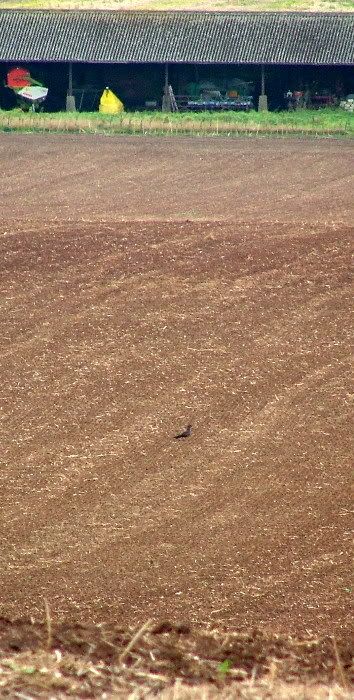
Alas, my photographs were distant.
Video 1 - Video 2
First target today was the long-staying juvie Long-tailed Skua in the south of Nottinghamshire. The bird was found two Mondays ago and still this morning there it was, staunchly quartering the stubble field its made a home of for two weeks, harassed only by the occasional Carrion Crow. Stunning bird too, the skua, in a sort of chocolate duffle coat plumage.

Alas, my photographs were distant.
Video 1 - Video 2
Much closer pictures can be found here, (apparently) taken with the landowners consent. That was the problem with this skua, every birder who traipsed the half mile out there knowing it to be a relatively tame individual had to muster all their self-restraint and hold back from blustering across the field for a better look. It was easy to see how sometimes birdwatchers pose a trespass nuisance, though I was surprised to find on a Saturday morning it just was the girlfriend and me with the bird to ourselves, maybe everybody else had already seen it?
Actually no, after pointing the bird out to a couple of new arrivals, it was time to make haste for Rutland and two more of the day's targets.
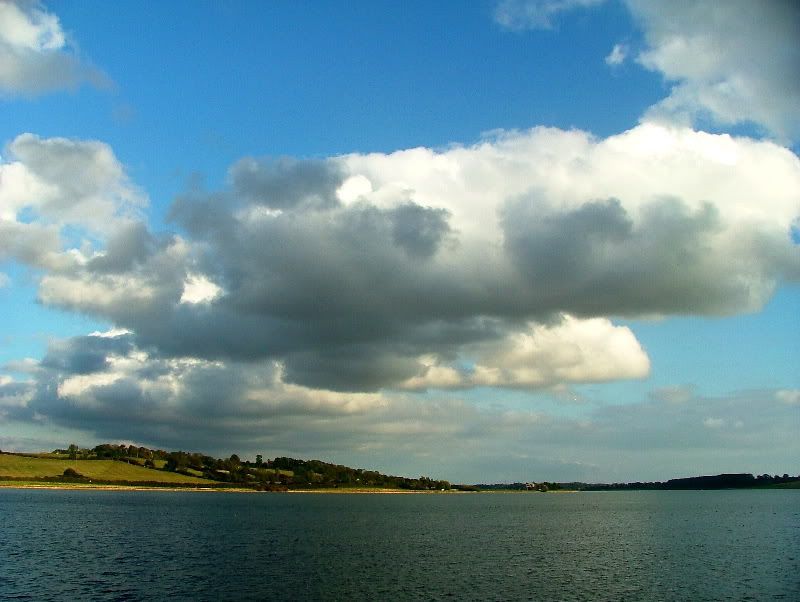 The scene at Rutland Water.
The scene at Rutland Water.
Third target was Red-necked Grebe, which I thought we'd missed after failing to find it in Manton Bay, where two days of reports had it located. Then having retired to pick up some waders at the Egleton Reserve, at 5pm just before turning home there it was, in the far distance from the last hide along, showing just enough plumage information to distinguish from a GCG. It was the broad dusky neck that did it, the Great Crested Grebe always has a pure white throat at all times of year.
So the moral of the story is never lose hope as long as you're still out there!
Other notables for the day; Little Gull, Artic Tern, Curlew and Green Sandpiper, Little Stint, Ruff, Little Egret, Black-necked Grebe, Whinchat.
64 species for the day, I'm sure several easy ticks overlooked in the hunt for the spectacular.
Some thumbnails:
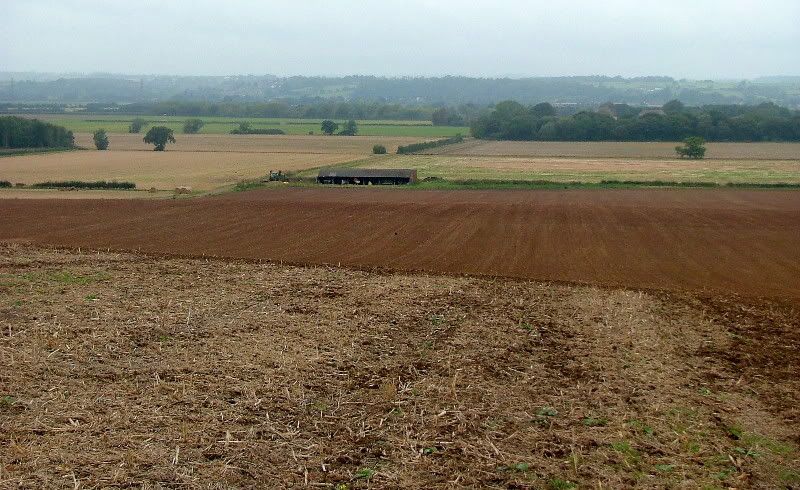 Spot the Skua!
Spot the Skua!
 Rutland waders.
Rutland waders.
 Green Sandpipers.
Green Sandpipers.
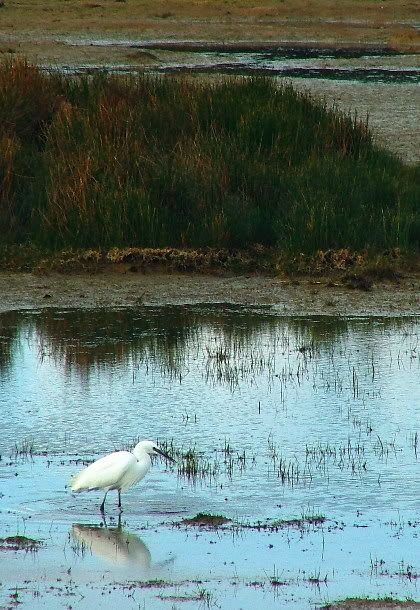 Little Egret.
Little Egret.
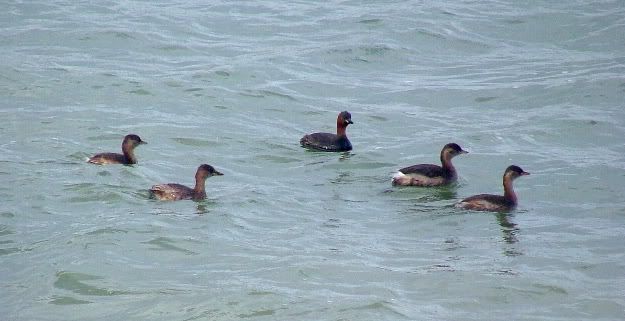 Dabchicks.
Dabchicks.
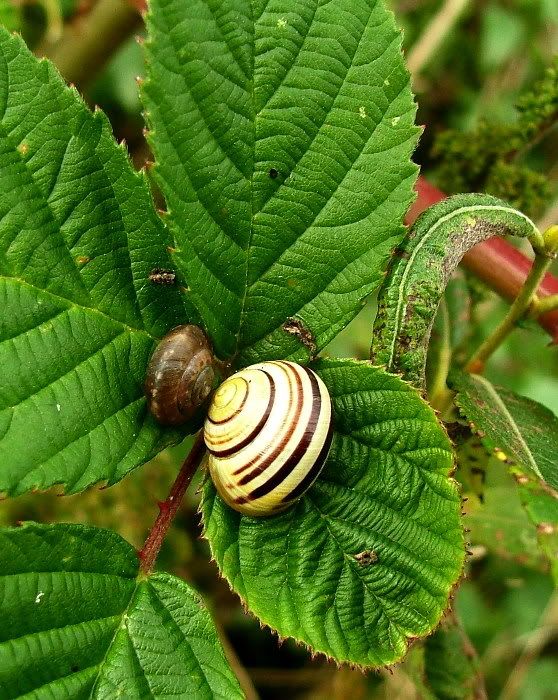
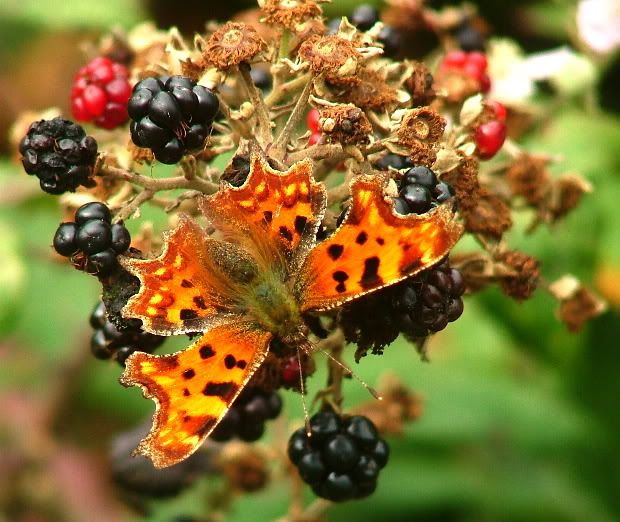 Comma.
Comma.
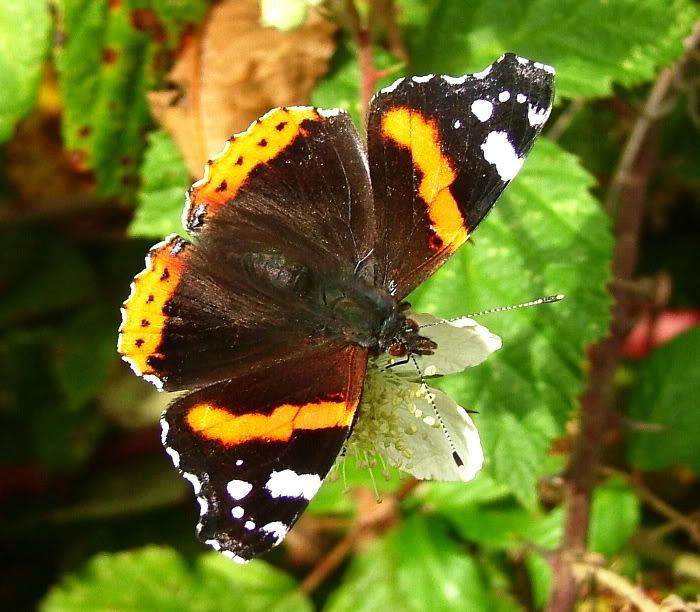 Red Admiral.
Red Admiral.
Actually no, after pointing the bird out to a couple of new arrivals, it was time to make haste for Rutland and two more of the day's targets.
 The scene at Rutland Water.
The scene at Rutland Water.First stop was the Lyndon Reserve, overlooking the Manton Bay area of the reservoir. Out there among the flurry of Commic Terns and Black-headed Gulls, was what we'd come for, a solitary juvenile Sabine's Gull, hawking and nipping up insects from the surface waters. As you can perhaps see here, the grey-white-black pattern of the wings is so very distinctive that you could call it from half a mile off. And here's a thought, it came all the way from Arctic Canada, or even Siberia!
Third target was Red-necked Grebe, which I thought we'd missed after failing to find it in Manton Bay, where two days of reports had it located. Then having retired to pick up some waders at the Egleton Reserve, at 5pm just before turning home there it was, in the far distance from the last hide along, showing just enough plumage information to distinguish from a GCG. It was the broad dusky neck that did it, the Great Crested Grebe always has a pure white throat at all times of year.
So the moral of the story is never lose hope as long as you're still out there!
Other notables for the day; Little Gull, Artic Tern, Curlew and Green Sandpiper, Little Stint, Ruff, Little Egret, Black-necked Grebe, Whinchat.
64 species for the day, I'm sure several easy ticks overlooked in the hunt for the spectacular.
Some thumbnails:
 Spot the Skua!
Spot the Skua! Rutland waders.
Rutland waders. Green Sandpipers.
Green Sandpipers. Little Egret.
Little Egret. Dabchicks.
Dabchicks.
 Comma.
Comma. Red Admiral.
Red Admiral.Finally, a couple of local spots, an Arctic Tern at Kings Mill Reservoir, one of several that passed through the county that day, and at Pleasley Colliery a Yellow-legged Gull. One of the individuals that roosts at Carsington Water maybe?
Oh, and just nipping out into the garden I heard a flock of Redwing going over. This time of year, pop your ear out at night and you could get them just about anywhere.
Oh, and just nipping out into the garden I heard a flock of Redwing going over. This time of year, pop your ear out at night and you could get them just about anywhere.
Subscribe to:
Posts (Atom)

